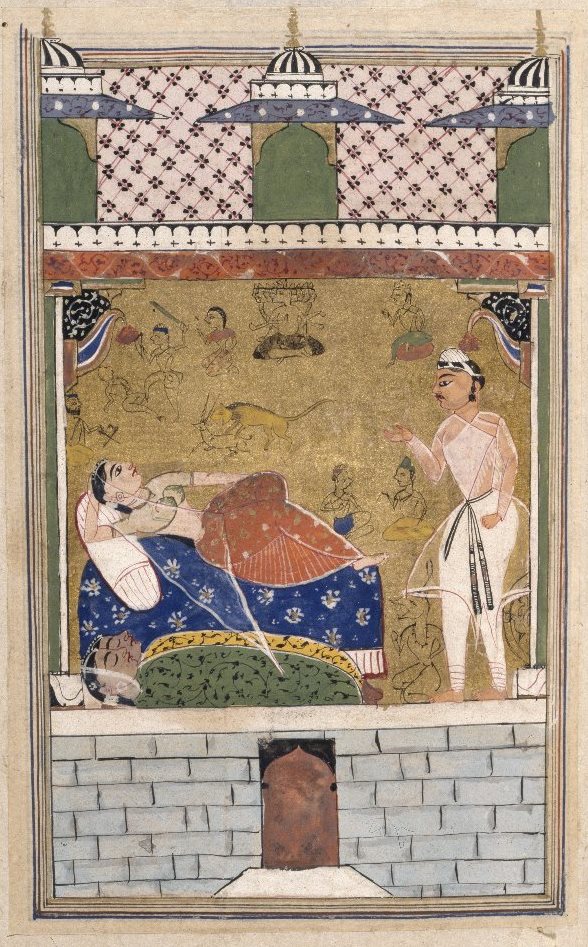Hindustani MS 1 has been digitised and is now available to view online in the Rylands Collection.
This sixteenth-century copy of the Laur-Chand by Maulana Daud is one of the Library’s most beautiful and important manuscripts.
Dr Jacqueline Suthren Hirst has kindly provided an introduction to the story and to our manuscript.
The story

Maulana Daud, a Sufi poet from Dalmau (modern Uttar Pradesh, India), composed his narrative of the hero, Laurak, and his beloved, Chanda, around 1377-78 A.D. Drawing on a popular north Indian regional folktale, which still circulates in vibrant performative traditions today, Daud used the language of Avadhi (or Hindavi) to compose the first surviving Indian Sufi romance, a model for later poets. Avadhi was both a courtly literary language and a vernacular; Daud used Persian masnavi conventions, such as opening verses in praise of Allah, the Prophet Muhammad and his four Companions, his patron and his own pir (Sufi teacher), alongside Indian images and settings, to create an Indo-Islamic story with wide appeal.The story tells of the mutual love of Laur (Lorik/Laurak), already married to Maina, and the beautiful Chand (or Chanda), separated from an unsuccessful childhood marriage. Brought together through the mediation of Chanda’s nanny, they run away together and face many trials, including Chanda’s near-fatal snakebites, the result of a curse. Eventually, they return to Maina, but the end of the story is unknown, none of the five surviving manuscripts being complete. Chanda’s beauty draws Laurak, the Sufi seeker, to God’s beauty; his ‘death’ to nafs, the ego-self, as she ‘dies’ at the second bite, hints at fana’, the annihilation of the seeker in God’s being alone.

Laurak has just scaled the wall to Chanda’s bedchamber, before they have actually met. He gazes on her beauty as she sleeps, her female companions failing to wake and guard her as they should. The verses opposite describe the gorgeous wall-hangings: the ten-headed demon Ravana, the capture of Sita, Rama preparing for battle, from the epic of Rama and Sita; the story of the Pandavas, from the Mahabharata, the other great Indian epic; lions and deer – all delicately etched on the walls ‘the colour of aloewood’, gold-leafed in the painting. In a moment, Laurak will wake Chanda, and the passion of their romance will begin…
The manuscript
The Manchester Chandayan is the most extensive extant manuscript, despite lacking beginning, end and some middle pages. A clever use of picture series draws readers into the story, immersing them in an experience which hints at emotions and unfolding action, creates suspense and engages them at the pace of the narrated tale. While previously the Manchester manuscript was seen as an inferior version of a common lost original better reproduced by the Mumbai Chandayan (Losty), Adamjee has now convincingly argued for its subtle independent narrative strategies intertwining paint and word. The 286 minatures are characteristed by a pastel palette, minimal underdrawing, infilling patterns drawn from fabric design, and extensive gold leaf. The text pages show a Persian section-caption in red ink, above five verses in chaupai rhyming couplets in two columns, with the final verse of each section, in longer doha metre, at the bottom of the page, all written in naskh script.

Origin: India (North Deccan workshop, or possibly court of Malwa), 16th century (possibly c.1570 A.D).
Physical description: 239 x 148mm, 636 paper pages, nineteenth-century leather flap binding.
Manuscript history: Formerly part of the collection of the Persian scholar Nathaniel Bland (1803-1865). Bland’s oriental manuscripts were sold through Bernard Quaritch in 1866 to Alexander Lindsay, 25th Earl of Crawford. The Crawford manuscript collection was purchased in 1901 by Enriqueta Rylands, founder of the John Rylands Library.
Further Reading
Adamjee, Qamar, ‘Strategies For Visual Narration in the Illustrated Chandayan Manuscripts’, unpublished doctoral thesis, (New York University: Institute of Fine Arts, 2011).
Hines, Naseem, Maulana Daud’s Cāndāyan: A Critical Study (New Delhi: Manohar, 2009).
Losty, Jeremiah, The Art of the Book in India (London: British Library Reference Division Publications, 1982).
Pandey, Shyam Manohar, The Hindi Oral Epic Loriki (Allahabad: Sahitya Bhawan, 1979).
___ The Hindi Oral Epic Canaini (Allahabad: Sahitya Bhawan, 1982).
___ ‘Love Symbolism in Candayan’, in Monika Thiel-Horstmann (ed.), Bhakti in Current Research 1979-1982 (Berlin: Dietrich Reimer Verlag, 1983), pp. 269-93.
Suthren Hirst, Jacqueline, ‘An Indian Sufi romance’, in John Hodgson (ed.), Riches of the Rylands (Manchester: Manchester University Press, 2015), p.211.



Pingback: The Laur-Chand: an Indian Sufi romance – Collections
Dr. Shyam Manohar Pandey would like to know if a hard copy of the above Laur Chand manuscript has been published. He needs to reproduce some text and illustrations for his forthcoming critical volume of the same in Hindi.
A hard copy has not been published. Our Heritage Imaging Team webpage provides information about ordering and publishing images (http://www.library.manchester.ac.uk/search-resources/manchester-digital-collections/hit/).
Are translations and transliteration of the text of this manuscript available or been worked on by anyone?
Hi Nimish,
Thanks for your comment. We aren’t aware of any translation or transliteration of the Laur Chand. The most recent work on the manuscript was a short account of it in ‘Riches of the Rylands’ (2015) by Dr Jackie Hirst, Senior Lecturer in South Asian Studies at Manchester: https://www.research.manchester.ac.uk/portal/en/researchers/jackie-hirst(fecb471c-67d0-49ed-9ba7-e2570dab8cdc).html.
Kind regards
John Hodgson
Thanks, John! Hope someone takes this on as a study – the material seems to in good shape and accessible.